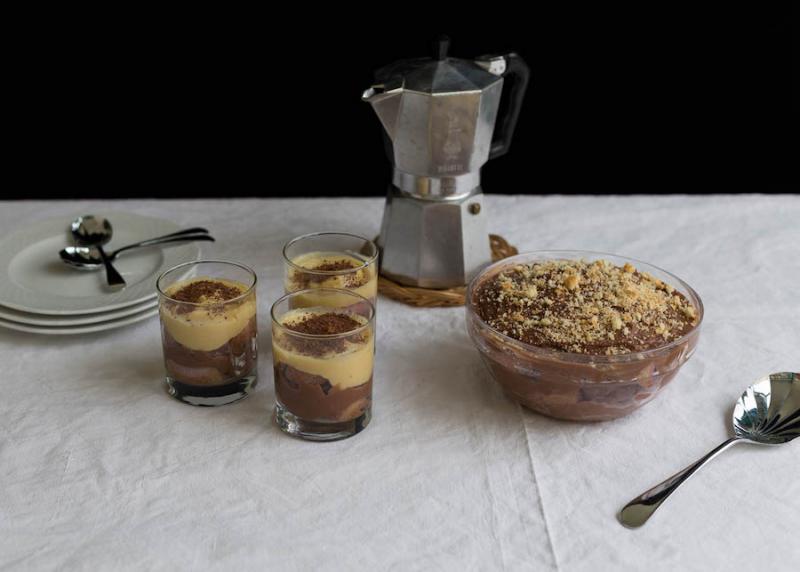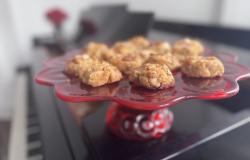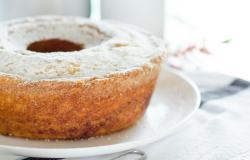Zuppa inglese

Made by layering pastry cream and sponge cake or biscuits dunked in pink-hued Alchermes liqueur, the dolce al cucchiaio or spoon dessert zuppa inglese is equally steeped in lore as it is in alcohol. Italians love nothing more than telling anecdotes about some of their signature dishes. This wonderfully boozy dolce, commonly prepared in central-northern Italy, is no exception and amusing legends surrounding its origins abound.
There's one story about a 16th century diplomat introducing it to his home city of Ferrara after enjoying the charms of another layered dessert at the Elizabethan court in London, the trifle. Another has it that a governess from an English family resident in Florence in the 1800s came up with the idea of dipping leftover biscuits in wine and placing layers of pastry cream and chocolate pudding on top. The most fanciful yarn, however, would have to be of its invention in Siena in 1552. The visiting Florentine ruler Cosimo de Medici was said to be so beguiled by the zuppa del duca ('duke's soup') served to him, that he took the recipe back to Florence. There, it was readily embraced by the city's large English expatriate population and renamed zuppa inglese, meaning 'English soup'.
With its striking resemblance to the trifle and its 'English' name, it's easy to see why many Italians are keen to ascribe this dessert a British origin or connection. Yet, foreign monikers aside, there is much evidence to suggest that zuppa inglese is a home-grown Italan dolce.
Consider, for example, the word zuppa. Derived from the verb inzuppare, which means 'to dunk', the Italian zuppa, French soupe and English sop once all referred to dishes featuring pieces of bread set to soak in a savoury or sweet liquid. A case in point is the zuppa magra inglese or 'lean English soup' from Cristoforo di Messisburgo's 1557 cookbook. A sweet-savoury concoction, it was made with stewed parsley roots in an egg-enriched broth which was poured over slices of bread and sprinkled with sugar and cinnamon. It was also published almost three decades before the trifle first appeared in Thomas Dawson's 1585 book of English cookery, The Good Huswifes Jewell.
So, what about the word inglese then? Well, Oxford Companion to Italian Food author Gillian Riley says it may refer to its above-mentioned ancestor dish's use of root vegetables. Another likely explanation, however, comes from when the dish began to take on an entirely sweet note by dunking slices of cake or biscuits in alcohol such as rhum and later Alchermes. At the time, British sailors were renowned for their fondness for the distilled beverage made from sugarcane.
A famous nineteenth century source also indicates an Italian origin for the dessert, Science in the Kitchen and the Art of Eating Well. Pellegrino Artusi, author of this seminal cookbook, included several recipes of British origin in his 1891 publication, including lesso rifatto all'inglese ('toad in a hole') and quattro quarti all'inglese (pound cake), complete with anecdotes about their history. In contrast, his entry about zuppa inglese makes no mention of any British origins. Most tellingly though, Artusi doesn't use the label all'inglese ('in the English style') that he does with his toad in a hole and pound cake recipes.
Whatever its origins, Italian, English or a bit of both, few would dispute how satisfying zuppa inglese is, as an afternoon snack or as a sweet conclusion to a meal. Below, you'll find a recipe, adapted from a Tuscan grandmother's, which works equally well served in one large bowl or in six individual glasses. If you're unable to locate Alchermes liqueur, rhum or Marsala make flavourful albeit less colourful substitutes. Please note also that the alcoholic content of these beverages can be diluted by adding some water or removed completely by bringing them to boil.
Ingredients (serves 4-6)

To make the pastry creams, heat the milk and grated lemon zest in a saucepan until it starts simmering. Remove from heat. In a separate stainless steel saucepan, whisk the eggs with the sugar and cornstarch, taking care to remove any lumps that may form. Continue to whisk while adding the heated milk in a slow and steady stream. Place saucepan on a low-flame and stir continuously until the cream thickens (about 5 – 10 minutes). Remove saucepan from heat and divide the cream into two bowls. Combine 50 g of the dark chocolate into one of the bowls. Stir until the chocolate has melted and is perfectly combined.
To assemble the zuppa inglese, take one bowl (measuring 18 cm in diameter and 9 cm in height) or 6 individual drinking glasses. Pour half a cup of Alchermes and half a cup of water into a bowl (N.B. the bowl may need to be refilled depending on how much liquid you soak your ladyfingers in). One by one, dip the biscuits (N.B. you will need to cut these in half if using indidual glasses) into the diluted liqueur and place side by side at the bottom of your bowl or glasses. Cover layer of ladyfingers with the chocolate pastry cream, followed by another layer of soaked ladyfingers and to finish, the plain pastry cream. Grate some dark chocolate for the garnish on top. Alternatively, you can reverse the position of your pastry creams and use the chocolate one as your top layer instead. If doing so, garnish with some crumbed ladyfingers instead. Cover and chill in the fridge for two hours or overnight before serving.
Buon appetito!





